Aircraft – Top Source of Airborne Lead Pollution in the U.S., in Oregon and in Washington County
There is no safe level of lead. This toxin is known to cause potentially irreversible damage even at very low levels. Children, pregnant women, unborn fetuses, communities of color and economically disadvantaged populations are disproportionately impacted by lead exposure and poisoning. Negative effects in children include, but are not limited to, diminished IQs, cognitive decrements, learning and behavior problems, ADHD, impulse control issues, and juvenile delinquency. In adults lead contributes to miscarriages, premature births, reproductive problems, kidney disease, coronary heart deaths and an increase in violent behaviors.
According to the Environmental Protection Agency (EPA), nationwide, lead emitted by piston-engine aircraft is responsible for 70%, 468 tons (close to a million lbs) annually, of all airborne lead emissions. General Aviation (GA) refers to civil aviation flights excepting those categorized as commercial or military. The majority of GA aircraft, including private, recreational, hobbyist and student training airplanes and helicopters flown in and out of the nearly 20,000 U.S. airports use leaded gasoline. Commercial and private jets use jet fuel which does not contain lead.
The National Academy of Sciences 2021 report, Options for Reducing Lead Emissions from Piston-Engine Aircraft (see pages 25-26), provides a breakdown of the more than 15 million hours logged by lead emitting piston-engine aircraft in 2019. Private pilots were responsible for 45%, pilot training more than 40%, aerial observation and agricultural services 6%, air taxis 2%, and an additional 6% for several categories combined including search and rescue, aerial firefighting, police aviation, traffic reporting and emergency medical airlift.
Based on updated data Air Traffic By The Numbers | Federal Aviation Administration (faa.gov), in the less than three years that have elapsed since 2019, the number of GA flight hours increased by a whopping 67% from 15 million to over 25.5 million. It is reasonable to assume that lead pollution produced by these aircraft has also increased commensurate with this enormous growth. (The lead emissions generated by aircraft from 2018 forward are not currently available in the EPA NEI database.)
U.S. Aviation Lead Emissions
The pie chart below depicts the 668 tons of facility source lead emissions released in the U.S. each year. The Mobile Aircraft sector is responsible for 70% of that amount. All other sectors, including, but not limited to, fuel combustion, industrial processes, steel mills, marine vessels, locomotives, and waste disposal, released 30%. [Envirofacts | US EPA]
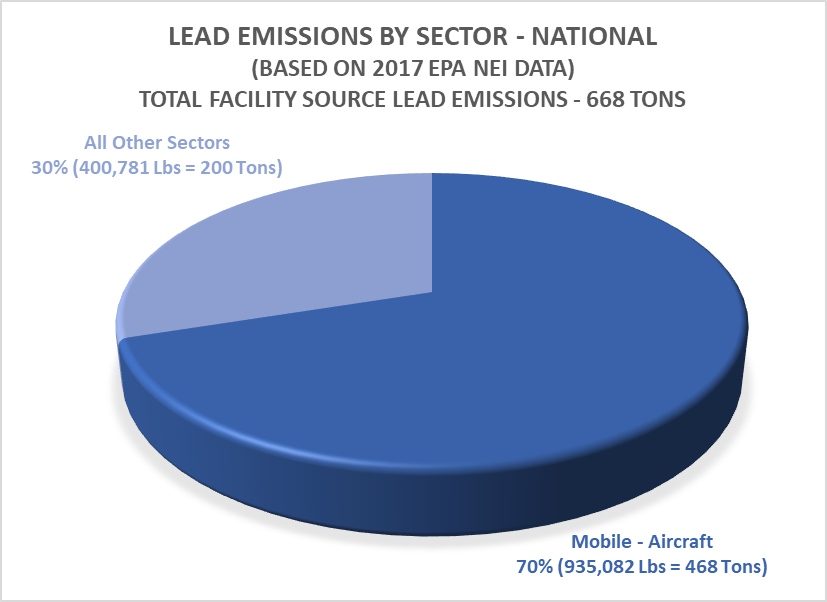
Mobile Aircraft Lead Emissions in Oregon
In Oregon the percentage of lead released by mobile aircraft, 87%, compared to all other sectors, is significantly higher than the nationwide numbers. Per the 2017 EPA National Emissions Inventory (NEI), Oregon releases 20,709 lbs, more than 10 and 1/3 tons of this neurotoxin, into the air every year. Of that amount, 18,230 lbs, over nine tons, are emitted by mobile aircraft—8,710 lbs is attributed to individual airports during the landing and take-off cycle and 9,520 lbs is emitted during the in-flight cruise phase. Heavy concentrations of ground-based lead, not included in the NEI database for individual airports, are released during pre-flight run-up procedures. [Envirofacts | US EPA]
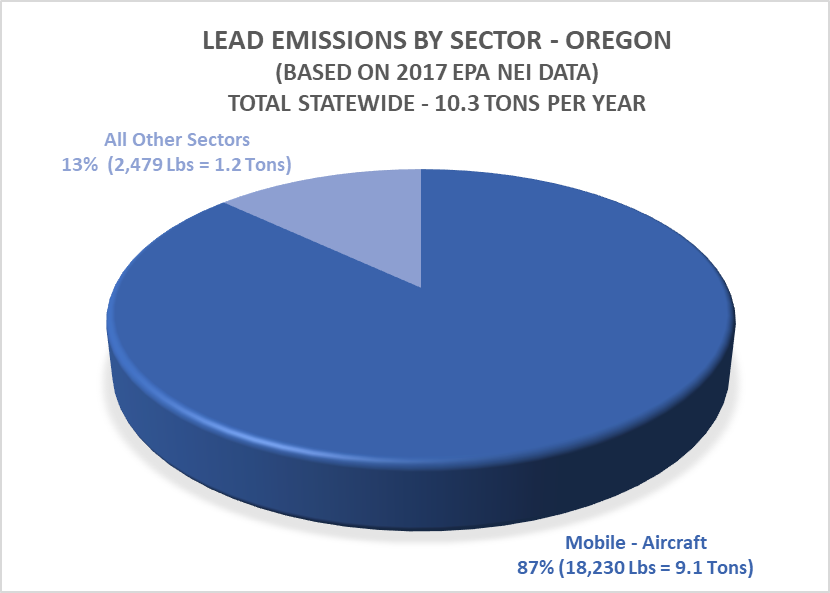
Washington County Lead Emissions
Of the 36 counties in Oregon, Washington County is the largest producer of lead emissions in the state. In fact, this jurisdiction generates more lead than the 19 lowest lead polluting counties, combined. Mobile aircraft are responsible for 93% of all lead emissions in Washington County, while all other sources, combined, total 7%. The largest source of these emissions is the Port of Portland owned and operated Hillsboro Airport (HIO), a facility that caters primarily to private pilots, the international flight training industry, foreign governments, out-of-state investment firms, charter businesses, and private jet owners.
The pie chart below shows that facility sources in Washington County emit 1,369 lbs of lead, 0.68 tons, annually. All other sectors combined release 101 lbs. [Envirofacts | US EPA]

The side-by-side comparison of the pie charts discussed above provides additional perspective on the extent to which mobile aircraft is the dominant source of airborne lead pollution in the U.S., Oregon and Washington County.

The bar chart below provides a picture of lead emissions by facility source in Washington County. The 2017 EPA NEI identifies 27 lead sources in Washington County. Twenty-two are airports, while the remaining five are non-aviation related. HIO emits more than nine times as much lead as Starks Twin Oaks, the second largest source of lead in the county, and thirty-five times as much lead as the 25 sources represented in the "All Others" column, which includes the total emissions of the twenty remaining airports and five non-aviation sources combined.
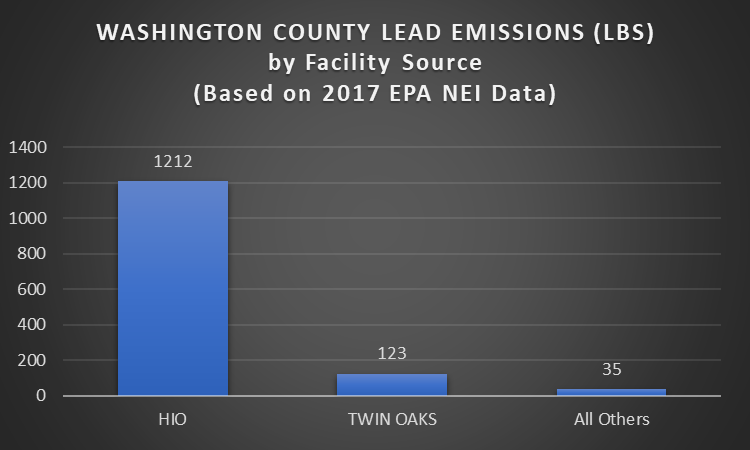
Oregon's Legacy of Lead Pollution
The next bar chart shows the top 15 lead emitting counties in Oregon. Washington County, where Hillsboro Airport is the top lead polluter, is number one. [Envirofacts | US EPA]
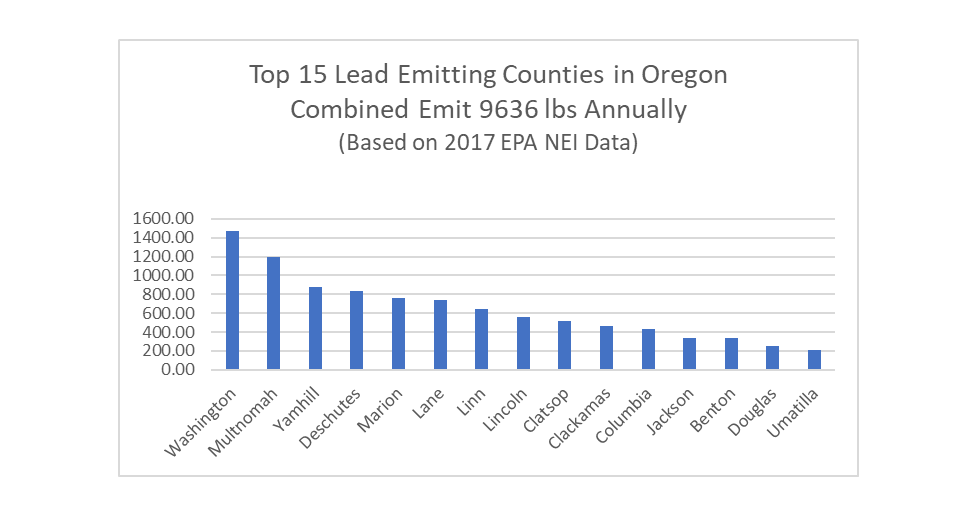
Multnomah County is the second most lead polluting jurisdiction in Oregon. The 41 facility sources of lead in this county release a cumulative total of 1064 lbs of lead into the atmosphere every year. More than two-thirds of that amount, 736 lbs is released by the 16 airports located in this county, while twenty-five non-aviation sources emit an additional 328 lbs. Troutdale Airport (554 lbs) is the largest lead polluter followed by Owens-Brockway Glass Plant (297 lbs). In third place is Portland International Airport (PDX) at 159 lbs.
There are 20 facility sources of lead in Yamhill County, where 862 lbs of lead are released into the air every year. This jurisdiction is the third largest lead polluting county in the state. Though Cascade Steel (359 lbs) is the top facility source of lead in this county, the remaining 19 sources are all airports which cumulatively emit 504 lbs of lead annually. McMinnville Airport (348 lbs) is the most lead polluting airport in Yamhill County followed by Chehalem (67 lbs) and Sportsman Airpark (65 lbs).
The fourth ranked lead polluting jurisdiction is Deschutes County. Bend Municipal is the second largest lead polluter in the state and largest facility source of lead in this jurisdiction. The flight training school, Leading Edge is one of the biggest offenders. Roberts Field, located 10 miles from Bend Municipal is also a significant source of lead pollution in this area. In 2017, Hillsboro Aero Academy began training Chinese pilots out of Roberts Field in Redmond. The FAA Terminal Area Forecast (TAF) indicates that between 2017 and 2019 the operational count at Roberts Field doubled. Though categorized as a commercial airport, more than 80% of the operations at this facility are general aviation. The lead emissions generated by the dramatic increase in air traffic due to flight training are not included in the 2017 NEI, thus it is likely that lead pollution levels at Bend Municipal, Roberts Field, Prineville, and Madras airports in Central Oregon are substantially higher than those recorded in 2017.
Three of the top 20 lead emitting airports in the state—Hillsboro, Troutdale and Portland International—are owned and operated by the Port of Portland. The Port has long profited from the sale of leaded fuel at their airports by affixing a fuel flowage fee to every gallon of gas sold. These facilities, combined, emit close to a ton of lead during the landing and take-off phase of flight every year. Additional lead is released during run-up procedures and the cruise phase of flight.
A review of the EPA NEI reveals 513 facility sources of lead in Oregon, 419 (82%) are airports.

Hillsboro Aero Academy – Major Contributor to Lead Pollution
A major source of lead pollution at a number of the top lead polluting airports in Oregon is Hillsboro Aero Academy—an airport tenant based primarily out of Hillsboro, Troutdale and Redmond (Roberts Field) in Central Oregon. Student pilots trained by this for-profit business fly in and out of Hillsboro, Bend, Troutdale, Scappoose, McMinnville and a number of other Oregon airports.
Hillsboro Aero Academy (HAA) boasts of training pilots from more than 75 countries. According to their website, about two-thirds of their student are from overseas with the majority coming from the Asian Pacific region. HAA states that it is "one of a handful of US-based flight schools authorized by the Civil Aviation Administration of China (CAAC) to train Chinese pilots." The screenshots below, last accessed on 10/012/2022, lists HAA's industry and collegiate partners [Why Choose HAA? | HillsboroAeroAcademy (flyhaa.com)]
All of the thirteen industry partners identified below, without exception, are from out-of-state and overseas. One of HAA's primary collegiate partners is Portland Community College (PCC), an educational institution that funnels taxpayer dollars into the toxic flight training industry via their Aviation Sciences program.


In addition, HAA is certified by the Civil Aviation Authority of Vietnam to train pilots for Vietnamese airlines and provides training to European pilots. More recently, HAA forged a partnership with Alaska Airlines and Horizon Air to provide pilot instruction.
It is HAA's student pilots in conjunction with their industry and collegiate partners, along with other flight training businesses including ATP and Hagele Aviation, that are responsible for much of the lead pollution over Washington County. The situation is further exacerbated by the private pilots, hobbyists and air taxis that also mercilessly pump toxins into our skies as well as training and recreational aircraft from neighboring airports. All of the above bear responsibility for compromising the health and well-being of impacted residents.
Aircraft Lead Distribution Network

This FlightRadar24 screenshot shows a 2-hour period on Thursday, September 15, 2022, between 12:30 and 2:30 pm. These types of flight tracks are generated throughout the day and into the nighttime hours by some of the top polluting airports in the state. The cluster of gray aircraft at the center is Portland International Airport (PDX), the 18th largest facility source of lead in Oregon. Most, but not all, of the aircraft using this facility use jet fuel rather than leaded gasoline, thus lead emissions at PDX are lower than at many general aviation airports. PDX flight tracks are more widely spaced, because most commercial jets are departing towards or arriving from airports in other states or countries.
Troutdale Airport (TTD), is located 9 miles east of PDX. On the map it appears to be buried beneath a pile up of multiple aircraft. TTD is the number one facility source of lead in Multnomah County, the 3rd largest facility source of lead in the state and one of the top 100 lead polluting airports in the country. The smaller orange cluster, 3 miles west of PDX is Pearson Field Airport. Located on the Vancouver, Washington, side of the Columbia; it, too, is a source of lead pollution.
Hillsboro Airport (HIO), the number one facility source of lead pollution in the state, is located 15 miles west of PDX. On the screenshot it appears as a dense orange cluster where multiple aircraft are taking off, landing and practicing touch-and-go maneuvers. HIO ranks 8th among approximately 20,000 U.S. airports on the list of the top lead polluting airports in the country. The tangle of flight tracks to the west, south and north of HIO depict student pilots practicing repetitive training maneuvers. Many routinely spew lead for an hour or more over homes, schools, day care centers, parks, neighborhoods, recreational areas and communities in the surrounding area, before returning to HIO.
Scappoose Airpark, the 6th largest facility source of lead in Oregon, is the dense orange area 14 miles north and slightly east of HIO. It attracts many Hillsboro Aero Academy students who routinely fly back and forth between the two airports.
McMinnville Airport, located 22 miles to the south of HIO in neighboring Yamhill County, is also a flight training facility. It is the 10th largest facility source of lead in the state.
In addition, aircraft from the Aurora Airport, 19 miles southeast of HIO, contribute to Oregon's lead footprint. Aurora Airport is the 4th largest facility source of lead in the state.
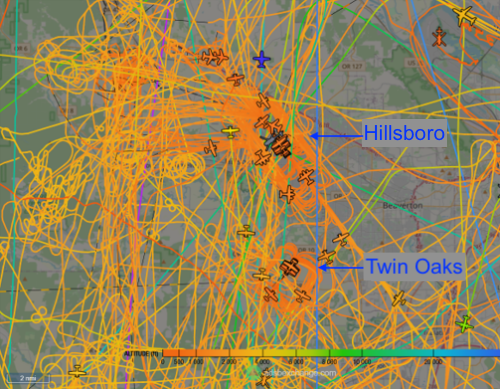
The screenshot above provides a close-up view of Hillsboro Airport traffic on June 8, 2022, between 7:00 am and 3:30 pm. It helps to explain how Washington County came to be the number one lead polluting jurisdiction in Oregon. The dense orange lines six miles south of HIO are flight tracks generated by Stark's Twin Oaks, a privately owned, public airport located in Hillsboro. Though not among the top 10 lead polluting Oregon airports, Stark's Twin Oaks (123 lbs per year) is a significant source of lead pollution.
As shown in a previous bar chart, these two airports are the top facility sources of lead in Washington County. The two airports combined spew 1,335 lbs of lead into the air every single year during the landing and take-off phase of flight and additional lead during run-ups, cruise phase and repetitive flight training maneuvers.
Take Action
The aviation industry poses a clear and present danger to health and well-being. This article provides details on the degree to which aircraft are responsible, on national, state and local levels, for intentionally and knowingly poisoning the people, wildlife, air, soil and water with layer upon layer of lead. This must stop! Those elected and appointed to serve in decision making capacities have a moral imperative to act on behalf of their constituents by initiating action to ban this pernicious toxin. Call your elected officials and demand they take immediate action now.
| © Oregon Aviation Watch | Contact Us |  Jump to Top Jump to Top |
